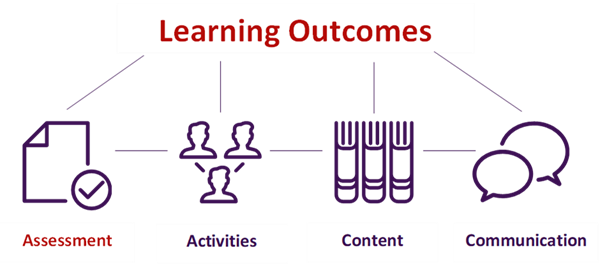This resource provides you with an introduction to ways to integrate technology into assessment design. It overviews the different considerations that need to be taken into account when designing assessment tasks in a blended learning environment.
This resource provides you with an introduction to ways to integrate technology into assessment design. It overviews the different considerations that need to be taken into account when designing assessment tasks in a blended learning environment.
Overview
On this page
Affordances of technology in assessment design Assessment task design Technology choice Example of Practice
The affordances of technology create new opportunities for assessment in blended learning environments. New technology and approaches should only be used where they will lead to equivalent or improved student experience or attainment of outcomes. Selecting specific technologies for assessment when they do not fit the objectives can waste time and override the quality of outcomes.
A key consideration when choosing an assessment strategy is its alignment with the learning outcomes. It's what the students 'do' that is important to the learning experience. You should first decide what it is you want students to do and experience, and then after that choose an appropriate technology.
The dominant model of curriculum design at ACU is what is known as the ‘acquire, assimilate, apply’ approach. This aligns in some respects to some of the layers of Bloom’s Taxonomy using a 3-level model. As such, learning outcomes tend to be developed to drive learning in the spaces of –

Depending on the main type of learning outcome being assessed, specific assessment types and aligned technologies may be suitable. The following table lists some assessments which align to these 3 categories of learning outcomes. Decisions on the type of assessment should be made before selecting a technology.
| Knowledge acquisition | Written examinations Reports Write an answer to a client's question Short answer questions Multiple Choice Questions |
|---|---|
| Demonstrating Understanding | Essays Reports Journals Case presentations (written or oral) Comments or discussions on theoretical perspectives |
| Application of understanding/Problem solving | Problem scenarios Group Work Work-based problem Prepare a committee of enquiry report Draft a research bid to a realistic brief Portfolio/ePortfolio Performance Presentation/webconference Demonstration Role Play Make a video or podcast Lab reports |
After determining the type of assessment approach aligned to a particular outcome, an appropriate technology may be used to facilitate an assessment task. This table gives some suggestions in relation to internal and external technologies that can be used. Please note that as technology changes fast, some of these suggestions may be a bit dated and new ones may exist to address your needs. Remember, the key decision to make is how they align to the learning outcomes of an assessment task.
In this video, David Spencer, Senior Lecturer-in-Law at the Thomas More Law School, discusses how he converted an in-person mock court hearing to a blended assessment in his second-year core law unit "LAWS201 Civil Procedure". David employed a contemporaneous online Court hearing using Zoom where students would appear via a Zoom split screen with David sitting as Judge and assessor in front of a backdrop of the Victorian Court of Appeal. The same formalities were observed as in an in-person hearing with students announcing their appearance and presenting their case in the same way as if they were standing in the actual court room. This video is an example of a blended authentic piece of assessment that replicates an actual court hearing.
Visit Service Central to access Corporate Services.